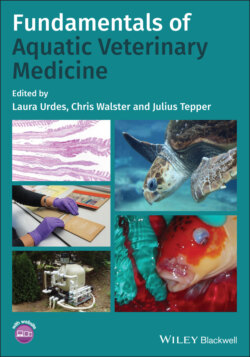Читать книгу Fundamentals of Aquatic Veterinary Medicine - Группа авторов - Страница 38
1.3.2.11 Conductivity, Salinity, Total Dissolved Solids
ОглавлениеConductivity is a measure of water’s capability to pass an electrical current. This ability is directly related to the concentration of ions in the water (US Environmental Protection Agency, 2016). These conductive ions come from dissolved salts and inorganic materials such as alkalis, chlorides, sulfides and carbonate compounds (Miller et al., 1988). Compounds that dissolve into ions are also known as electrolytes (Sommer and Spitzer, 2004). The more ions that are present, the higher the conductivity of water. Likewise, the fewer ions that are in the water, the less conductive it is. A sudden increase in pond conductivity can indicate pollution. Agricultural runoff or a sewage leak will increase conductivity due to the additional chloride, phosphate, and nitrate ions.
Salinity is a measure of the total concentration of dissolved solids, usually in parts per thousand (ppt). Anions (negatively charged) are chloride, sulfate, bicarbonate and bromide. Cations (positively charged) are sodium, magnesium, calcium, potassium, and strontium. Sodium and chloride are the major solids. Because the electrolytes form ionic particles as they dissolve, each with a positive and negative charge, salinity is a strong contributor to conductivity. The concentration of water is as follows:
Freshwater: less than 2 ppt
Brackish water: 2–16 ppt
Saltwater: 35 ppt.
Most aquatic organisms can only tolerate a specific salinity range (Clean Water Team, 2002). The physiological adaptation of each species is determined by the salinity of its surrounding environment. Salinity tolerances depend on the osmotic processes within an organism. Fish and other aquatic life that live in fresh water (low salinity) are hyperosmotic (cells have a high ability to eliminate water and retain ions). On the other side of the spectrum, saltwater (high salinity) organisms are hypo‐osmotic and maintain a lower internal ionic concentration than seawater. Most species of fish are stenohaline, exclusively freshwater, or exclusively saltwater (Myers, 1949). However, there are a few organisms that can adapt to a range of salinities. These euryhaline organisms can be anadromous, catadromous or true euryhaline. Anadromous organisms live in saltwater but spawn in freshwater. Catadromous species are the opposite – they live in freshwater and migrate to saltwater to spawn (Myers, 1949). True euryhaline species can be found in saltwater or freshwater at any point in their life cycle (Myers, 1949). Estuarine organisms are true euryhaline.
The sum of all ion particles that are smaller than 2 microns (0.0002 cm) is the total dissolved solids. This includes all the disassociated electrolytes that make up salinity concentrations, as well as other compounds such as dissolved organic matter. Freshwater aquasystems should have less than 2000 mg/l of total dissolved solids and most water sources should have much less than that (American Public Health Association et al., 2017).
